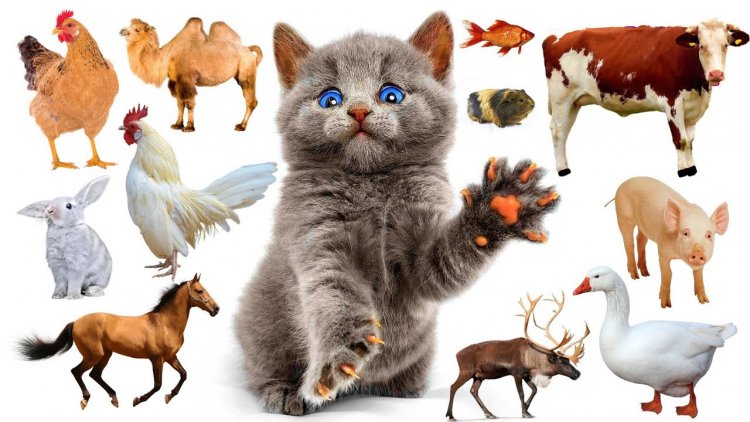How often have you been advised to look at the world differently? To remove the rose-colored glasses, to take a look at something at a different angle, to become simpler, or, on the contrary, a little more serious. We are ready to suggest you do the same, but in a much more interesting way. Let's have a look at the world through the eyes of our pets.
Cats
Cats are believed to have acute vision. So, why don't they notice a treat right next to them for a long time and start sniffing around in panic instead? The reason for that lies in the peculiarities of their vision. The ideal distance for a cat's gaze to examine an object is from 75 centimeters to 6 meters. Though, it is important to note that the heirs of predators can distinguish objects at the distance of up to 60 meters, but they see very poorly at close range. This is where their sense of touch comes to the rescue. So, if your cat does not take a treat from your hands for too long, you should know that it is not its whims, but the peculiarity of perception.
Another interesting feature is the shape of cats’ pupils. You are probably familiar with the expression "cat's gaze" or the simile "cat's eyes." A cat's pupil is very sensitive to the incoming light and changes its shape instantly: in the dark – it dilates greatly, and in the bright light – it narrows down to a thin vertical strip. Besides, a cat's cornea is more convex than that of a human, so instead of a usual 180-degree view, it has an angle of 270 degrees.
A cat’s vision is seven times more acute than ours, but this only applies to moving objects (evolution gave the feline family this kind of vision so that they could be successful hunters); as for static objects, cats see them very poorly or simply do not notice them.
As for color perception, it is also different from that of a human. Cats have no cones, responsible for shades of red, orange, brown. They hardly distinguish between white, purple, and yellow. They do not see the difference between dark blue and light blue. However, they perceive green and blue colors very well, they can also distinguish between more than twenty variations of gray color. The reason for this is that the food they hunt for in their natural environment (rodents and birds) is of gray color. Apparently, they see everything around them, including their owners, in gray and light blue, and the sun in green and light blue. Cats excellently orient at night thanks to an increased number of rods in the structure of their eyes, which are responsible for peripheral night vision. Moreover, they have a special layer – tapetum, which makes their eyes glow in the dark. It acts as a mirror and improves the perception of light at night.
Dogs
A dog's retina can be mentally divided into two halves. The upper half is responsible for night vision and the lower half is responsible for day vision. This is why dogs, in general, can see well both during the day and at night. However, dogs' vision is not as sharp as that of a human, because their eye has no central fovea with photoreceptors. To some extent, this is compensated by panoramic vision. It helps observing a moving object with a fixed gaze. Most accurately dogs' vision reacts to movement. As for static objects, dogs can distinguish them only at a distance of 100-150 meters. Just like cats, dogs see poorly at close range.
Dogs do not distinguish all colors. It doesn't mean that they see the world in black and white, but their picture is much dimmer than that of a human. Dogs don't have cones that perceive red and green, so they see objects of these colors as yellow and gray. Dogs see much better in the dark than humans do; much like cats, they have many more rods that are responsible for the night vision as their pupils are also covered with tapetum.
Even though there are many similarities between the vision of cats and dogs, we should keep in mind that cats are nocturnal animals whereas dogs are diurnal. Mother Nature created cats as stealth predators, while dogs chase their prey. Therefore, cats have bigger eyes and a sharper vision.
However, vision characteristics differ from breed to breed. The peripheral vision of dogs with wide flattened muzzles is not so great, but they can see objects better at close range (ornamental breeds). Animals with elongated muzzles (hunting breeds predominantly) see well at a distance and have a wider field of view.
Birds
A canary on a windowsill also sees the world differently. Birds are tetrachromats, which means they see four colors instead of those three we are used to. In addition to the blue, green, and red that we perceive, they also see ultraviolet. In pictures and diagrams, it is often depicted as purple, but this is only done for humans to distinguish it. Birds see it differently because, by definition, ultraviolet has no color.
Scientists proved this ability with a curious experiment. They took 166 species of North American songbirds, which, at first glance, had no difference in coloration between males and females. However, the observed the birds were able to distinguish ultraviolet feathers in each other's coloration, thus easily differentiating between female and male birds. During another experiment, scientists placed identical – in human perception – stuffed yellow-breasted chats in a wildlife environment. Live male individuals began defending their territory from the supposed males and courted the supposed females. The birds saw things that a human eye could not.
However, it doesn't mean that birds see better than humans. Even though they have four cones instead of three, they have less space in the fundus of the eye for each of them. Presumably, this has a negative effect on a resolving power in low light.
Birds have the largest eyes among animals in relation to their body size. Their structure has an element known as a ridge, and their movement is restricted by a special sclerotic ring. The eye is protected by an additional transparent membrane. The structure of a bird's eye is similar to that of a reptile. It has a developed ciliary muscle, which allows the lens to change shape faster than it does in mammals.
The birds' vision largely depends on their species. Birds of prey see sharper and accurately estimate the distance to an object. Nocturnal birds distinguish colors poorly, but they see very well in low light. Terns, seagulls, and albatrosses can see well into the distance even during fog due to the red or yellow oil droplets in their eyes. Moreover, birds can see magnetic fields and unmistakably determine the way to warm countries.
Rodents
Rodents see well at close range and are good at perceiving moving objects, but if you do not move, neither a mouse nor a pet rat will notice you until they physically bump into you. At the same time, if you start waving your hands, the rodent will see it even at a distance of 10-15 meters and run away.
Rats have panoramic vision and the image received by each eye is perceived autonomously by the brain and may differ. This is why it is difficult for them to see what is right in front of them and perceive the depth of an object's location.
Rats can only distinguish two colors: blue and green. For them, red turns into ordinary dark spots. Nonetheless, they can see ultraviolet, which helps them to recognize their own and other rats' territories by the marks they leave. The retina of these animals is divided in an unequal ratio: 1% of cones responsible for color and 99% of rods which enable them to see at night. However, the vision of rats is far from being acute. They see dozens of times worse than humans, but they can move their eyes in opposite directions simultaneously and see the world in slow motion, as their brain perceives information much faster than their eyes can transmit it.
Read about the experiment of imitating rodent vision in our article.
Insects
There are three types of insect eyes: compound (faceted), simple (dorsal), and larval (lateral). The most common type is the faceted eyes. The same type is observed in crustaceans and some other arthropods. Owners of this type of eyes distinguish ultraviolet radiation and flashing with a frequency of up to 250-300 Hz (human vision can only perceive up to 50 Hz). However, they do not see details well, as their vision is similar to a pixelized picture.
Faceted eyes are located on both sides of a head and are characterized by being motionless. They consist of ommatidia in a form of narrow elongated cones (their tips converge inside the eyes). Each segment is responsible for its own area of an image; as a consequence – the image looks like a mosaic.
Simple eyes are usually located on top of a head. In most cases, insects have three simple eyes and no ommatidium in their structure. Owners of such eyes are not characterized by good vision. That is why most often simple eyes are complemented by several compound eyes.
Larval eyes are located on top of a head and, during the stage of transformation from a pupa to an insect, they transform into compound eyes. These eyes provide very poor vision.
Each type of an eye structure affects the peculiarities of object’s visual perception. The vision of bees is the best studied one. Bees can only see blue and green, and distinguish colors in the ultraviolet spectrum. In their perception, flowers look like ultraviolet colored spots, so bees fly to the brightest of them, as those have more pollen.
Evidently, you are unlikely to have a mosquito or a bee in a jar at home as a pet. However, we can mention some curious fact about uninvited guests in your house – namely, flies: just like rats, they perceive movements in slow motion. That is why they have time to slip away from a fly swatter or folded newspaper.
Fish
If you open your eyes underwater, everything will be blurry, but not for the fish. They can see artificial seaweed in a water tank quite clearly and vividly. It is assumed that their natural habitat is murky water, so they can distinguish the image at a distance of 5 cm even if the visibility is very poor, but they see poorly in the distance, except for the predatory fish, which can spot the prey at a distance of 15 meters already.
Both eyes can cover what is happening at an angle of 270 degrees, which means that a fish sees objects both in front and located slightly behind. In order to see the image in volume, a fish needs to turn to the object of interest, as the eyes are located on both sides of a head. This is why the image is almost always flat.
Fish eyes do not have eyelids, so they never close. Their pupils do not react to changes in brightness. If the light is too bright, a fish can even go blind. Not all underwater inhabitants are able to distinguish colors, but some of them can see red, green, yellow, and blue. However, due to the refraction of light underwater, it is almost impossible to make out an outside picture.
The article is based on open sources.
Photo on the homepage: youtube.com




























